Superior general of the Society of Jesus
| Superior General of the Society of Jesus | |
|---|---|
| Praepositus Generalis | |
 Seal of the Society of Jesus | |
since 14 October 2016 | |
| Formation | 19 April 1541 |
| First holder | Ignatius of Loyola |
| Part of a series on the |
| Society of Jesus |
|---|
 |
| History |
| Hierarchy |
| Spirituality |
| Works |
| Notable Jesuits |
|
|
The superior general of the Society of Jesus is the leader of the Society of Jesus, the Catholic religious order also known as the Jesuits. He is generally addressed as Father General. The position sometimes carries the nickname of the Black Pope, because of his responsibility for the largest male religious order, in contrast with the white garb of the pope. The thirty-first and current superior general is Fr Arturo Sosa, elected by the 36th General Congregation on 14 October 2016.[1]
Titles
[edit]
The formal title in Latin is Praepositus Generalis, which may fairly be rendered as "superior general" or even, "president general". The term is like that of military usage (and Ignatius of Loyola had a military background) which is derived from "general", as opposed to "particular". This usage is consistent with other Catholic religious orders, like the Dominicans' "master general", Franciscans' "minister general", Carthusians' "prior general", and with civil posts such as Postmaster General and Attorney General. The Jesuits are organized into provinces, each with a provincial superior, (usually referred to as the "Father Provincial" or just "Provincial"), with the head of the order being the "general superior", for the whole organization. As a major superior, the Superior General is styled "Very Reverend".
Black Pope
[edit]"Black Pope" is an unofficial designation given to the position of Superior General of the Order of the Jesuits.[2] The name follows from his leadership of the largest Catholic, male religious order[3] and from the colour of the plain black cassock worn by members of the Society, including the Superior General.[4] This may have originated from a past concern (most prominent around the 16th and 17th centuries) among Protestant European countries concerning the relative power of the Jesuits within the Roman Catholic Church, and partly because the Superior General, like the Pope, is elected for life.

Powers
[edit]The Superior General is invested with governing power over all the members of the Society, but customarily leads through Provincial superiors under him. Such power follows from the religious vows that bind members to community life, as in other religious orders.
Succession
[edit]Superiors General are elected by the General Congregation of the Society, summoned upon the resignation or death of an incumbent. Superiors General are elected for life and up to recently, as with the Popes, have served life terms. The exceptions being Father Pedro Arrupe (resigned for reasons of failing health) and both his successors, Father Peter Hans Kolvenbach and Father Adolfo Nicolás. On 2 October 2016, General Congregation 36 convened in Rome, convoked by Superior General Nicolás, and it elected Father Arturo Sosa as the thirty-first Superior General.
List of Superiors General
[edit]Until the 21st century, it was customary for Superiors General to rule for life. Where they left office before death, the date of death is listed below the date they left office. (Pedro Arrupe resigned in 1983 after a paralyzing stroke.)
| No. | Superior General | Portrait | Took office | Left office Deceased |
Birthplace[a] | Duration (in days) |
|---|---|---|---|---|---|---|
| 1 | Ignatius of Loyola | 
|
April 19, 1541 | July 31, 1556 | Azpeitia, Spain | 5,582 |
| 2 | Diego Laynez | 
|
July 2, 1558 | January 19, 1565 | Almazán, Spain | 2,393 |
| 3 | Francis Borgia | 
|
July 2, 1565 | October 1, 1572 | Gandia, Spain | 2,648 |
| 4 | Everard Mercurian | 
|
April 23, 1573 | August 1, 1580 | La Roche-en-Ardenne, Belgium | 2,657 |
| 5 | Claudio Acquaviva | 
|
February 19, 1581 | January 31, 1615 | Atri, Italy | 12,399 |
| 6 | Mutio Vitelleschi | 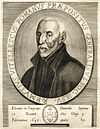
|
November 15, 1615 | February 9, 1645 | Rome, Italy | 10,679 |
| 7 | Vincenzo Carafa | 
|
January 7, 1646 | June 8, 1649 | Naples, Italy | 1,248 |
| 8 | Francesco Piccolomini | 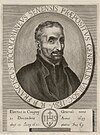
|
December 21, 1649 | June 17, 1651 | Siena, Italy | 543 |
| 9 | Aloysius Gottifredi | 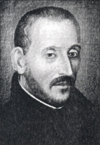
|
January 21, 1652 | March 12, 1652 | Rome, Italy | 51 |
| 10 | Goschwin Nickel | 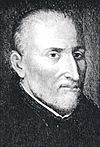
|
March 17, 1652 | July 31, 1664 | Jülich, Germany | 4,519 |
| 11 | Giovanni Paolo Oliva | 
|
July 31, 1664 | November 26, 1681 | Genoa, Italy | 6,327 |
| 12 | Charles de Noyelle | 
|
July 5, 1682 | December 12, 1686 | Brussels, Belgium | 1,621 |
| 13 | Thyrsus González de Santalla | 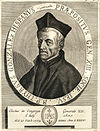
|
July 6, 1687 | October 27, 1705 | Arganza, Spain | 6,688 |
| 14 | Michelangelo Tamburini | 
|
January 31, 1706 | February 28, 1730 | Modena, Italy | 8,521 |
| 15 | Franz Retz | 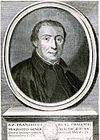
|
March 7, 1730 | November 19, 1750 | Prague, Bohemia | 7,562 |
| 16 | Ignacio Visconti | 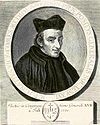
|
July 4, 1751 | May 4, 1755 | Milan, Italy | 1,389 |
| 17 | Aloysius Centurione | 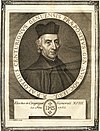
|
November 30, 1755 | October 2, 1757 | Genoa, Italy | 672 |
| 18 | Lorenzo Ricci | 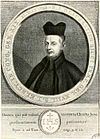
|
May 21, 1758 | August 16, 1773 24 November 1775 21 July 1773 (suppressed) |
Florence, Italy | 5,566 |
| — | Stanislaus Czerniewicz[b] | 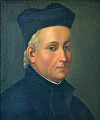
|
October 17, 1782 | October 21, 1785 | Kaunas, Polish–Lithuanian Commonwealth | 1,100 |
| — | Gabriel Lenkiewicz[b] | October 8, 1785 | October 21, 1798 | Polotsk, Polish–Lithuanian Commonwealth | 4,761 | |
| — | Franciszek Kareu[c] | 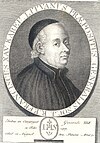
|
February 12, 1799 | August 11, 1802 | Orsha, Polish–Lithuanian Commonwealth | 1,275 |
| — | Gabriel Gruber[d] | 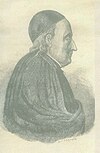
|
October 22, 1802 | April 6, 1805 | Vienna, Austria | 897 |
| 19 | Tadeusz Brzozowski[e] | 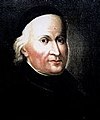
|
August 7, 1814 | February 5, 1820 | Königsberg, Prussia | 2,008 |
| 20 | Luigi Fortis | 
|
October 18, 1820 | January 27, 1829 | Verona, Italy | 3,023 |
| 21 | Jan Roothaan | 
|
July 9, 1829 | May 8, 1853 | Amsterdam, Netherlands | 8,704 |
| 22 | Peter Jan Beckx | 
|
August 2, 1853 | March 4, 1887 | Scherpenheuvel-Zichem, Belgium | 12,267 |
| 23 | Anton Anderledy | 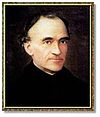
|
March 4, 1887 | January 18, 1892 | Berisal, Switzerland | 1,781 |
| 24 | Luis Martín | 
|
October 2, 1892 | April 18, 1906 | Melgar de Fernamental, Spain | 4,945 |
| 25 | Franz Xavier Wernz | 
|
September 8, 1906 | August 20, 1914 | Rottweil, Germany | 2,903 |
| 26 | Wlodimir Ledóchowski | 
|
February 11, 1915 | December 13, 1942 | Loosdorf, Austria | 10,167 |
| 27 | Jean-Baptiste Janssens | 
|
September 15, 1946 | October 5, 1964 | Mechelen, Belgium | 6,595 |
| 28 | Pedro Arrupe | 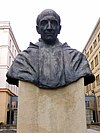
|
May 22, 1965 | September 3, 1983 5 February 1991 |
Bilbao, Spain | 6,678 |
| 29 | Peter Hans Kolvenbach | 
|
September 13, 1983 | January 14, 2008 26 November 2016 |
Druten, Netherlands | 8,889 |
| 30 | Adolfo Nicolás | 
|
January 19, 2008 | October 3, 2016 20 May 2020 |
Villamuriel de Cerrato, Spain | 3,169 |
| 31 | Arturo Sosa | 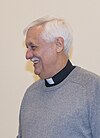
|
October 14, 2016 | Incumbent | Caracas, Venezuela | 3,018 |
Leadership during suppression
[edit]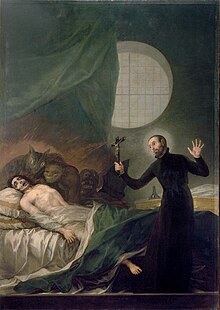
In 1773, the Jesuits were suppressed by Pope Clement XIV, through the Papal brief Dominus ac Redemptor on 21 July 1773, executed 16 August. The leaders of the order, in the nations where the Papal suppression order was not enforced, were known as temporary Vicars General.
The temporary Vicars General were:
- Stanislaus Czerniewicz (17 October 1782 – 21 October 1785)
- Gabriel Lenkiewicz (8 October 1785 – 21 October 1798)
- Franciszek Kareu (12 February 1799 – 7 March 1801)
On 7 March 1801, Pope Pius VII issued the brief Catholicae fidei, giving approval to the existence of the Society in Russia and allowing the Society there to elect a Superior General for Russia. This was the first step to the Society's eventual restoration.
The Superiors General in Russia were:
- Franciszek Kareu (7 March 1801 – 11 August 1802)
- Gabriel Gruber (22 October 1802 – 6 April 1805)
- Tadeusz Brzozowski (14 September 1805 – 7 August 1814)
The order was restored on 7 August 1814, by Pope Pius VII, through the papal bull Sollicitudo omnium ecclesiarum.
See also
[edit]Notes
[edit]References
[edit]- ^ "Jesuits elect first Latin-American general". Crux. 2016-10-14. Retrieved 2017-05-30.
- ^ commandprompt6 (1993). A view from Rome: on the eve of the modernist crisis. Fordham University Press. p. Back cover. ISBN 0823213595.
{{cite book}}: CS1 maint: numeric names: authors list (link) - ^ "Jesuit | religious order". Encyclopedia Britannica. Retrieved 2017-05-30.
- ^ "Spaniard becomes Jesuits' new "black pope"". Reuters. 2008-01-19. Retrieved 2022-01-19.


